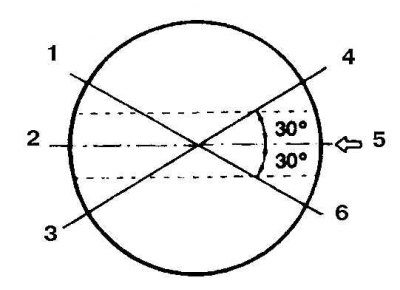Checking the lubrication clearance of connecting rod bearings

1. Clean the upper connecting rod bearing and install it on the connecting rod. The lubrication holes of the connecting rod and bushing must be aligned.
2. Clean the second bearing and install it in the connecting rod cap.

1. Clearance of the upper oil scraper ring
2. Gap of expansion ring
3. Clearance of the lower oil scraper ring
4. Clearance of the upper compression ring
5. Piston pin
6. Gap of the second compression ring
3. Position the piston ring end gaps as shown.
4. Lubricate the pistons and rings and compress the piston rings with a piston ring compressor.
5. Rotate the crankshaft so that the connecting rod bearing of the first cylinder is in the bottom dead center position, and lubricate the cylinder walls.

6. Check that the mark on the top of the piston is facing forward.

7. Press down on the piston and install it into the cylinder.

8. An internal micrometer or other special device can be used to measure the lubrication gap, but the most accurate and easiest method is to use a special plastic gauge.

9. After installing the piston in the cylinder, tighten the connecting rod cap bolts and check the connecting rod bearing lubrication gap in the same way as checking the main bearing lubrication gap.
10. If the clearance is not correct, the wrong size bushings may have been installed.
Final installation of pistons and connecting rods
1. Remove all traces of plastic. Check that the surface of the bearings is absolutely clean and lubricate them with engine oil.
2. Install the connecting rod on the shaft journal, install the connecting rod cap and tighten the nuts to the correct torque.
3. The rest of the connecting rods are installed in the same way.
4. After installing all the connecting rods, rotate the crankshaft several times and check for ease of movement.
5. Check the end play of the connecting rods.
